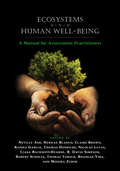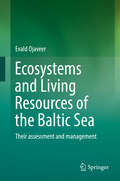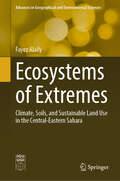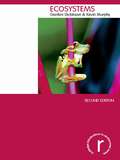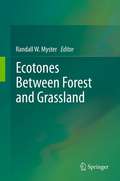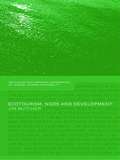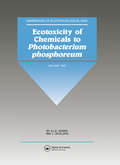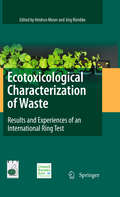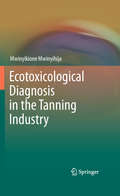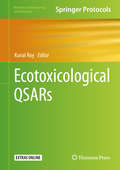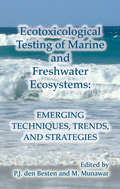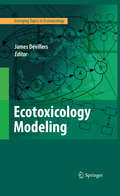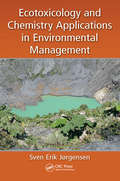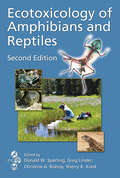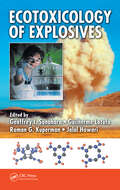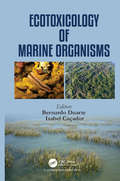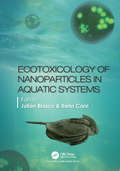- Table View
- List View
Ecosystems and Human Well-Being: A Manual for Assessment Practitioners (Five Volume Set Ser.)
by Thomas Tomich Monika Zurek Neville Ash Hernán Blanco Keisha Garcia Bhaskar ViraDesigned by a partnership of UN agencies, international scientific organizations, and development agencies, the Millennium Ecosystem Assessment (MA) is the most extensive study ever of the linkages between the world's ecosystems and human well-being. The goal of the MA is to establish the scientific basis for actions needed to enhance the contribution of ecosystems to human well-being without undermining their long-term productivity. With contributions by more than 500 scientists from 70 countries, the MA has proven to be one of the most important conservation initiatives ever undertaken, and the ecosystem services paradigm on which it is based provides the standard for practice. This manual supplies the specific tools that practitioners of the paradigm need in order to extend their work into the future. The manual is a stand-alone "how to" guide to conducting assessments of the impacts on humans of ecosystem changes. In addition, assessment practitioners who are looking for guidance on particular aspects of the assessment process will find individual chapters of this manual to be useful in advancing their understanding of best practices in ecosystem assessment. The manual builds on the experiences and lessons learned from the Millennium Ecosystem Assessment global and sub-global assessment initiatives, with chapters written by well-known participants in those initiatives. It also includes insights and experiences gained from a wider range of ecosystem service-focused assessment activities since the completion of the MA in 2005.
Ecosystems and Living Resources of the Baltic Sea
by Evald OjaveerThis volume presents a reconstruction of the formation of the environmental conditions and biota in the present-day Baltic Sea area during the last glacial cycle and thereafter under the influence of extra-terrestrial, climatic and geological factors. Abiotic conditions in the contemporary Baltic Sea (water salinity, temperature, oxygen and light conditions, currents and other water movements) are characterized and in this background the natural regional system of the sea has been generated. Important issues are considered such as life forms in the Baltic and their dependence on the natural environment (both in the conditions of the relative stable environment and during the regime shifts), as well as anthropogenic influences and the basic differences between the areas of the World Ocean and the brackish Baltic Sea. This book also equips readers with basic principles of assessments and management of ecosystems and fish resources (including the long-term assessment and forecast on ecosystems and fish resources) and provides information on the structures of international collaboration developed in the Baltic Sea.
Ecosystems and Their Interactions, Student Guide
by Carolina Biological Supply Company/Smithsonian Science Education CenterNIMAC-sourced textbook
Ecosystems of Extremes: Climate, Soils, and Sustainable Land Use in the Central-Eastern Sahara (Advances in Geographical and Environmental Sciences)
by Fayez AlailyThis book explores the environmental conditions, particularly the climate and soils, of one of the driest regions on earth, the Central-East of the Sahara. These factors control the ecosystems and determine the land's suitability for use. The area receives only 0.5 mm of precipitation annually and contains one of the largest aquifers in the Sahara, with fossil groundwater. The region's lithology includes Cretaceous formations and crystalline rocks, largely covered by quaternary sediments. Exogenous activities have shaped various landscape types, such as ergs with different dunes, deflated depressions with playas, and yardangs. Soils in the region are primarily formed through physical processes and are often shallow, sandy, and enriched with soluble salts. The book provides a detailed analysis of their physical and chemical properties, genesis, and relation to environmental factors and sociological aspects. It also discusses rare ecosystems, including those dependent on food imports and those that arise episodically and last for a few years. Considering all ecological parameters, a land assessment system for irrigated agriculture is developed, along with descriptions of suitable cultivation methods and optimal irrigation systems. The book's contents are based on data from several expeditions and laboratory work funded by the German Research Foundation.
Ecosystems: A Functional Approach (Routledge Introductions to Environment: Environmental Science)
by Kevin Murphy Gordon DickinsonIn examining both theory and applications, this book, through useful examples, provides a stimulating introduction to ecosystems. It examines the nature, types and characteristics of ecosystems as well as investigating the interactions between various systems and human actions. Using functional ecology as the basis for applying the ecosystem concept in contemporary environmental science and ecology, this second edition of this highly successful volume has been updated to reflect the latest research. It incorporates a strengthened theme in the use of functional ecology in explaining how ecosystems work and how the ecosystem concept may be used in science and applied science, and coverage of the interactions between humans and ecosystems has been substantially bolstered with the addition of chapters on human impacts and large scale impacts on ecosystems, and global environmental change and the consequences for ecosystems.Presented in a student-friendly format, this book features boxed definitions, examples, case studies, summary points, discussion questions and annotated further reading lists. It provides a concise and accessible synthesis of both ecosystem theory and its applications, and will be a valuable resource for students of environmental studies, ecology and geography.
Ecotheology: A Christian Conversation
by Alan G. Padgett Kiara JorgensonJust as God loves creation, so are Christians called to care for it. Now, amid the accelerating degradation of our global environment, that task has taken on greater urgency than ever. How should Christians respond to the climate crisis and widespread pollution of earth&’s shared commons, water and air? How might Christian communities think about human responsibility to other living creatures? In roundtable format, Richard Bauckham, Cynthia Moe-Lobeda, Steven Bouma-Prediger, and John F. Haught navigate the layers of what it means for humans to live in right relationship with earth&’s lifesystems. After each contributor&’s essay, the other three contributors issue a response—including points of disagreement and questions—thereby modeling for readers productive and respectful dialogue. The ecumenical conversations in Ecotheology represent the diverse viewpoints of contributors&’ theological and practical commitments, exploring creation care through a variety of frameworks, including natural science, biblical studies, systematic theology, and Christian ethics.
Ecotones Between Forest and Grassland
by Randall W. MysterEcotones are dynamic over-lapping boundary areas where major terrestrial biomes meet. As past studies have shown, and as the chapters in this book will illustrate, their structure, size, and scope have changed considerably over the millennia, expanding and shrinking as climate and/or other driving conditions, also changed. Today, however, many of them are changing at a rate not seen for a long time, perhaps largely due to climate change and other human-induced factors. Indeed ecotones are more sensitive to climate change than the biomes on either side, and thus may serve as critical early indicators of future climate change. As ecotones change, they also redefine the limits of the biomes on either side by altering their distributions of species because, in addition to their own endemic species, any ecotone will also have species from both adjoining biomes. Consequently, they may also be places of high levels of species interaction, serving as active evolutionary laboratories, which generate new species that then migrate back into adjacent biomes. Ecotones Between Forest and Grassland explores how these ecotones have changed in the past, how they are changing today, and how they are likely to change in the future. The book includes chapters from around the world with a special focus on South American and Neotropical ecotones.
Ecotourism and Environmental Sustainability: Principles and Practice
by Tim GaleThis book offers conceptual and practical insights into the complex interactions between ecotourism and the natural environment, with consideration given to government policy, marketing by suppliers, consumer behaviour and visitor/environmental management. Illustrated by international case studies the roles of and interplay between tour operators, their clients, resource managers and local communities are examined. This creates a comprehensive and insightful overview of the factors that work for and against the achievement of environmental sustainability in and through ecotourism. The result is a critical examination of ecotourism and environmental sustainability that highlights ideas for best practice and proposes new directions for future research
Ecotourism and Indonesia's Primates (Developments in Primatology: Progress and Prospects)
by Sharon L. Gursky Jatna Supriatna Angela AchornThe basic goal of the volume is to compile the most up to date research on the effect of ecotourism on Indonesia’s primates. The tremendous diversity of primates in Indonesia, in conjunction with the conservation issues facing the primates of this region, have created a crisis whereby many of Indonesia’s primates are threatened with extinction. Conservationists have developed the concept of “sustainable ecotourism” to fund conservation activities. National parks agencies worldwide receive as much as 84% of their funding from ecotourism. While ecotourism funds the majority of conservation activities, there have been very few studies that explore the effects of ecotourism on the habitat and species that they are designed to protect. It is the burgeoning use of “ecotourism” throughout Indonesia that has created a need for this volume where the successes and pitfalls at various sites can be identified and compared.
Ecotourism, NGOs and Development: A Critical Analysis (Contemporary Geographies of Leisure, Tourism and Mobility #Vol. 8)
by Jim ButcherEcotourism has emerged over the last twenty years not just as a market niche, but also as a strategy for combining development with conservation in the developing world. Ecotourism, NGOs and Development considers the basis for advocacy and argues that it is premised upon a very limited and limiting view of the potential for development. Jim Butcher examines the advocacy of tourism as sustainable development in a range of NGOs and within the general literature. The research reveals that in spite of the plethora of critical commentaries on the operation of ecotourism projects, there is generally an uncritical take on the ideological basis of the projects. This book offers a timely critique of key assumptions underlying ecotourism's status as sustainable development, arguing that ecotourism as development strategy ties the fate of some of the poorest people on the planet to localized environmental imperatives.
Ecotoxicity of Chemicals to Photobacterium Phosphoreum
by K. L. E. Kaiser J. DevillersEach volume in the series focuses on a particular taxon, presenting detailed and reliable ecotoxicological results from both laboratory and field experiments, performed for a comprehensive range of chemicals. A taxonomical guide to the species is given, together with relevant biological and ecological information.In recent times much attention has been focused on the effects of anthropogenic emissions of chemicals. This series is unique in providing a considered estimate of the potential impact of such chemicals on the environment.
Ecotoxicological Characterization of Waste
by Heidrun Moser Jörg RömbkeAccording to the European Waste List, waste must be characterized as ecotoxicologically hazardous or not. This book provides the background, organization, methods, results and recommendations regarding this specific classification and assessment of waste.
Ecotoxicological Diagnosis in the Tanning Industry
by Mwinyikione MwinyihijaThe primary focus in this book is to identify the ecotoxicological impacts related to the tanning industry on terrestrial and aquatic systems. The research incorporated both field related and laboratory based techniques in the experimental design to address the underlying environmental problems in the tanning sector. First, the study aimed to investigate the occupational hazards within a tannery caused by contaminated dust. An optical set-up involving microscopy and digital imaging techniques was initially used to determine dust particle numbers and size distributions. After determining the particulate numbers and sizes a Monte Carlo method was used to estimate the concentration of the dust in the air throughout the tannery during an 8 h working day. However knowing the particulate quantitative profile is always not sufficient to adjudge the toxic potency of the dust. In retrospect therefore the work related to the book inclined a notch higher to determine the toxic nature of the dust (in addition to particle size relation to toxicity). Therefore an ecotoxicological screening of the dust samples for the first time (using a solid and liquid assay involving the response of luminescence (lux)-based bacterial biosensor) was conducted and complemented by chemical analysis to identify possible causative toxic components. In the second phase of the study, the tannery effluent and associated environmental samples were dissected and manipulated through sparging, treatment with activated charcoal, filtration and pH adjustment. The approach used highlighted the complexiity of toxic pollutants in the effluent from the tanning industry and the potential for remediation. Third, with the tannery effluent discharged into the adjacent river system (used for domestic and agricultural purposes) a partial environmental impact study (integrating toxicity assessment, measurement of microbial biomass activity and chemical analysis) was conducted with the main objective of investigating the river health status. Finally, three specific objectives were also achieved at the end of the investigation: characterization of effluents and sediments and riverine samples, assessment of ecotoxicity and bioremediation potential of primary contaminants and input of environmental risk assessment through development of a quantitative and qualitative risk assessment model also for the first time reported for the tanning industry. This initiative was primarily for the grand purpose of establishing the ecotoxicological impact of the tanning industry using the most current developed bioassays.
Ecotoxicological QSARs (Methods in Pharmacology and Toxicology)
by Kunal RoyThis volume focuses on computational modeling of the ecotoxicity of chemicals and presents applications of quantitative structure–activity relationship models (QSARs) in the predictive toxicology field in a regulatory context. The extensive book covers a variety of protocols for descriptor computation, data curation, feature selection, learning algorithms, validation of models, applicability domain assessment, confidence estimation for predictions, and much more, as well as case studies and literature reviews on a number of hot topics. Written for the Methods in Pharmacology and Toxicology series, chapters include the kind of practical advice that is essential for researchers everywhere. Authoritative and comprehensive, Ecotoxicological QSARs is an ideal source to update readers in the field with current practices and introduce to them new developments and should therefore be very useful for researchers in academia, industries, and regulatory bodies.
Ecotoxicological Testing of Marine and Freshwater Ecosystems: Emerging Techniques, Trends and Strategies
by M. Munawar P.J. den BestenFocusing on state-of-the-art biological testing and methods used for aquatic ecosystem health assessment, Ecotoxicological Testing of Marine and Freshwater Ecosystems evaluates the latest bioassay techniques and different types of water and sediment quality assessments. The book also explores multi-tiered approaches to making recommendations for th
Ecotoxicology Modeling
by James DevillersEcotoxicology Modeling is a comprehensive and well-documented text providing a collection of computational methods to the ecotoxicologists primarily interested in the study of the adverse effects of chemicals, their mechanisms of action and/or their environmental fate and behavior. Avoiding mathematical jargon, the book presents numerous case studies to enable the reader to understand the interest but also the limitations of linear and nonlinear models in ecotoxicology. Written by an international team of scientists, Ecotoxicology Modeling is of primary interest to those whose research or professional activity is directly concerned with the development and application of models in ecotoxicology. It is also intended to provide the graduate and post-graduate students with a clear and accessible text covering the main types of modeling approaches used in environmental sciences.
Ecotoxicology and Chemistry Applications in Environmental Management (Applied Ecology and Environmental Management)
by Sven Erik JorgensenEcotoxicology and Chemistry Applications in Environmental Management describes how to set up an integrated, holistic approach to addressing ecotoxicological problems. It provides detailed explanations in answer to questions like "Why is it necessary to apply an integrated approach?" and "How does one apply an integrated environmental management approach?" Highlighted topics of the book include Environmental chemical calculations QSAR estimation methods Toxic substance interference with other environmental problems Using diagnostic ecological subdisciplines for solutions Cleaner production methods and technologies Environmental risk assessment Addressing one of the most difficult tasks today, this book provides a much-needed holistic view for translating scientific knowledge and research results into effective environmental management measures. Rooted in a seven-step method, it integrates examination and quantification of an environmental problem and describes the use of ecological diagnostic tools to develop a diagnosis for ecosystem health. It also presents methods for choosing and using solutions or combinations of solutions to tackle problems.
Ecotoxicology of Amphibians and Reptiles
by Christine A. Bishop Donald W. Sparling Greg Linder Sherry K. KrestBuilding on the success of its popular predecessor, the second edition of Ecotoxicology of Amphibians and Reptiles presents newly available findings on the species that are important environmental indicators. This new edition covers nearly twice as many topics as the first, including recent developments in the ecotoxicology of amphibians and reptil
Ecotoxicology of Explosives
by Geoffrey I. Sunahara Guilherme Lotufo Roman G. Kuperman Jalal HawariManaging sites contaminated with munitions constituents is an international challenge. Although the choice of approach and the use of Ecological Risk Assessment (ERA) tools may vary from country to country, the assurance of quality and the direction of ecotoxicological research are universally recognized as shared concerns. Drawing on a multidiscip
Ecotoxicology of Marine Organisms
by Bernardo Duarte Maria Isabel Violante CaçadorThis book presents a comprehensive review of the most recent studies on the impact of contaminants on the marine environment. Conventional and new information, as well as the latest techniques, are presented, which can be applied to several types of marine organisms from bacteria and fungi to animals and algae. Specific topics discussed include the impact of different contaminants on different organisms as well as different approaches and their outcomes in terms of impact assessment. The integration of these techniques is also discussed in order to attain sentinel species and biomarkers to be applied for assessing ecological quality and impact assessment programs and studies.
Ecotoxicology of Nanoparticles in Aquatic Systems
by Julián Blasco Ilaria CorsiThe use of nanoparticles in medicine, industrial, and other applications has triggered an interest in their potential. This book explores the use of nanoparticles related to their occurrence in the environment, their impact on biota in aquatic systems, application of new methodologies, and changes associated with new global scenarios. The book also covers the bioaccumulation and internalization of nanoparticles as key aspects to assess their uptake and discusses the methodologies for testing ENPs ecotoxicity at different trophic levels.
